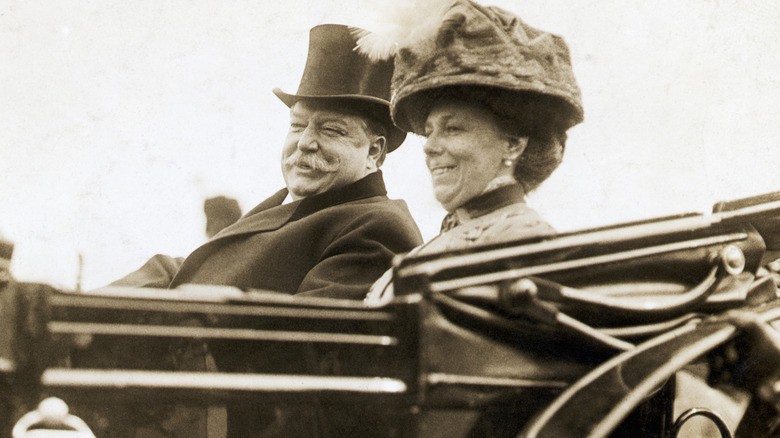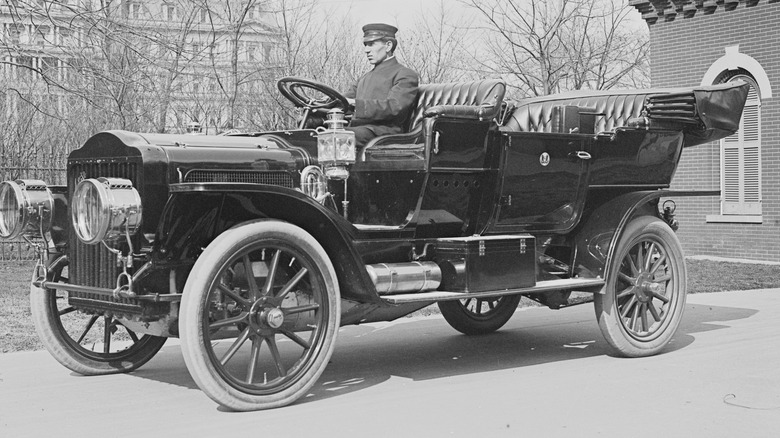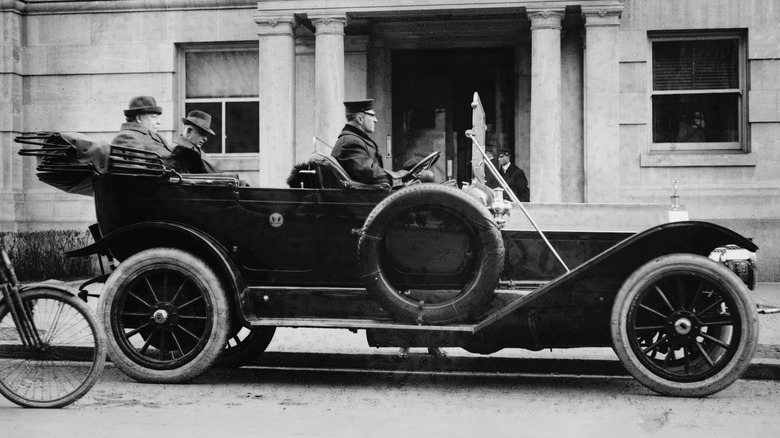America's First Presidential Car: The Story Behind The Historic Vehicle
Throughout the 100-year tradition of presidential automobiles, there have been some pretty unexpected cars that former presidents used to own. It's hard to pin down exactly when this tradition started, but the first president to ride in a car in general was William McKinley. Just before 1900, Freelan O. Stanley, an inventor who manufactured steam-driven automobiles, invited President McKinley to take a ride in his car while in office. While it was an experience McKinley didn't particularly enjoy because the earliest cars weren't exactly made with luxurious comfort in mind, it set the stage for future presidents to form their own motorcades.
Theodore Roosevelt pushed the tradition ahead when he became the first president to ride in a car publicly in 1902, cruising through the streets of Hartford in a Columbia Electric Victoria Phaeton. This wasn't a common occurrence for him, as Roosevelt preferred horses. Nonetheless, on that day in Hartford, he was surrounded by an old school paparazzi of men on bicycles and horseback — which was essentially the first presidential motorcade.
It was President William Howard Taft, an actual automobile enthusiast, who cemented the tradition with a Model M and a Pierce Arrow. Here's the story behind the first official U.S. presidential motor cars.
The first presidential cars were a Model M and a Pierce Arrow
Everything changed when Henry Ford introduced the revolutionary Model T in 1908. Cars became far more widely available and pretty soon, the majority of U.S. citizens owned one — including the president. William Howard Taft officially introduced the idea of the presidential car in 1909, and Congress funded the purchase of a White Motor Company Model M and a Pierce Arrow for him and his family to ride in.
Taft went against the grain and seemed to prefer cars to horses, which is why he decided to construct a new garage on presidential grounds to replace the federal stables. The White Motor Company Model M was a steam-powered, seven-passenger car with 40 horsepower. It had a dark green body and a United States coat of arms painted on the doors. He and his wife, First Lady Helen Herron Taft, also rode in the Pierce Arrow, a six-cylinder car with 48 horsepower. This vehicle also featured the U.S. seal on the doors but was blue instead.
Later, the presidential family secured a Baker Electric from the famous Baker Motor Vehicle Company as well. This was a two-seater reserved for the First Lady's use, and it also served the next four First Ladies as well, including Ellen Wilson, Edith Wilson, Florence Harding, and Grace Coolidge.
Not everyone was a fan of the presidential car
While Taft was rapidly motorizing the White House, not everyone celebrated Congress appropriating funds for presidential cars. Tennessee Democratic Representative Thetus Sims, for example, argued at the time that the automobile was a "a dangerous means of travel, not only for the people who ride in it but for the pedestrians." He went even further, describing the automobile as "an all around nuisance."
Nevertheless, Taft seemed unphased by such indignation and gradually became a bit of a spokesman for the burgeoning automobile industry. A self-proclaimed motorist, he was the first president to attend an auto show, hosted participants in cross-country endurance motoring, and officially endorsed the motor car, greatly accelerating the development of city streets.
While President-Elect Woodrow Wilson went old school with a horse-drawn carriage for his 1913 inaugural parade, the general tradition of the presidential car continued thereafter, with added security, convenience, and definitely more U.S. flags. It's safe to say McKinley would be a little more comfortable in what modern presidents ride in today, though he might be alarmed by the fridge full of the president's blood type that the service carries along with them in the motorcade.


